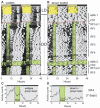Comment on "Differential rescue of light- and food-entrainable circadian rhythms"
- PMID: 18974333
- PMCID: PMC2583785
- DOI: 10.1126/science.1161387
Comment on "Differential rescue of light- and food-entrainable circadian rhythms"
Abstract
Fuller et al. (Reports, 23 May 2008, p. 1074) reported that the dorsomedial hypothalamus contains a Bmal1-based oscillator that can drive food-entrained circadian rhythms. We report that mice bearing a null mutation of Bmal1 exhibit normal food-anticipatory circadian rhythms. Lack of food anticipation in Bmal1-/- mice reported by Fuller et al. may reflect morbidity due to weight loss, thus raising questions about their conclusions.
Figures

Comment on
-
Differential rescue of light- and food-entrainable circadian rhythms.Science. 2008 May 23;320(5879):1074-7. doi: 10.1126/science.1153277. Science. 2008. PMID: 18497298 Free PMC article.
References
Publication types
MeSH terms
Substances
Grants and funding
LinkOut - more resources
Full Text Sources
Molecular Biology Databases

